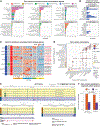Developmental isoform diversity in the human neocortex informs neuropsychiatric risk mechanisms
- PMID: 38781356
- PMCID: PMC11960787
- DOI: 10.1126/science.adh7688
Developmental isoform diversity in the human neocortex informs neuropsychiatric risk mechanisms
Abstract
RNA splicing is highly prevalent in the brain and has strong links to neuropsychiatric disorders; yet, the role of cell type-specific splicing and transcript-isoform diversity during human brain development has not been systematically investigated. In this work, we leveraged single-molecule long-read sequencing to deeply profile the full-length transcriptome of the germinal zone and cortical plate regions of the developing human neocortex at tissue and single-cell resolution. We identified 214,516 distinct isoforms, of which 72.6% were novel (not previously annotated in Gencode version 33), and uncovered a substantial contribution of transcript-isoform diversity-regulated by RNA binding proteins-in defining cellular identity in the developing neocortex. We leveraged this comprehensive isoform-centric gene annotation to reprioritize thousands of rare de novo risk variants and elucidate genetic risk mechanisms for neuropsychiatric disorders.
Conflict of interest statement
Figures






Update of
-
Developmental isoform diversity in the human neocortex informs neuropsychiatric risk mechanisms.bioRxiv [Preprint]. 2023 Oct 11:2023.03.25.534016. doi: 10.1101/2023.03.25.534016. bioRxiv. 2023. Update in: Science. 2024 May 24;384(6698):eadh7688. doi: 10.1126/science.adh7688. PMID: 36993726 Free PMC article. Updated. Preprint.
References
Publication types
MeSH terms
Substances
Grants and funding
- R01 MH110928/MH/NIMH NIH HHS/United States
- R01 MH117406/MH/NIMH NIH HHS/United States
- R01 MH124018/MH/NIMH NIH HHS/United States
- U01 MH103365/MH/NIMH NIH HHS/United States
- U01 MH116489/MH/NIMH NIH HHS/United States
- R21 MH109956/MH/NIMH NIH HHS/United States
- R01 MH116529/MH/NIMH NIH HHS/United States
- U01 MH103346/MH/NIMH NIH HHS/United States
- U01 MH103339/MH/NIMH NIH HHS/United States
- U01 MH116487/MH/NIMH NIH HHS/United States
- R21 MH105881/MH/NIMH NIH HHS/United States
- R01 MH126393/MH/NIMH NIH HHS/United States
- R01 MH110926/MH/NIMH NIH HHS/United States
- U01 MH116488/MH/NIMH NIH HHS/United States
- U01 MH116438/MH/NIMH NIH HHS/United States
- U01 MH116442/MH/NIMH NIH HHS/United States
- R01 MH094714/MH/NIMH NIH HHS/United States
- R56 MH114901/MH/NIMH NIH HHS/United States
- U01 MH122591/MH/NIMH NIH HHS/United States
- T32 MH073526/MH/NIMH NIH HHS/United States
- R01 MH117292/MH/NIMH NIH HHS/United States
- T32 GM008042/GM/NIGMS NIH HHS/United States
- R21 MH103877/MH/NIMH NIH HHS/United States
- R01 MH110905/MH/NIMH NIH HHS/United States
- U01 MH122509/MH/NIMH NIH HHS/United States
- R01 MH110927/MH/NIMH NIH HHS/United States
- U01 MH122678/MH/NIMH NIH HHS/United States
- U01 MH116441/MH/NIMH NIH HHS/United States
- R01 MH121521/MH/NIMH NIH HHS/United States
- U01 MH122849/MH/NIMH NIH HHS/United States
- R01 MH125252/MH/NIMH NIH HHS/United States
- R56 MH114899/MH/NIMH NIH HHS/United States
- U01 MH103392/MH/NIMH NIH HHS/United States
- R01 MH117291/MH/NIMH NIH HHS/United States
- U01 MH122590/MH/NIMH NIH HHS/United States
- R01 MH117293/MH/NIMH NIH HHS/United States
- R01 MH109677/MH/NIMH NIH HHS/United States
- R56 MH114911/MH/NIMH NIH HHS/United States
- R01 MH105472/MH/NIMH NIH HHS/United States
- R01 MH129301/MH/NIMH NIH HHS/United States
- P30 AI028697/AI/NIAID NIH HHS/United States
- R01 MH111721/MH/NIMH NIH HHS/United States
- R01 MH126459/MH/NIMH NIH HHS/United States
- U01 MH103340/MH/NIMH NIH HHS/United States
- U01 DA048279/DA/NIDA NIH HHS/United States
- R01 MH110920/MH/NIMH NIH HHS/United States
- U01 MH122681/MH/NIMH NIH HHS/United States
- R21 MH102791/MH/NIMH NIH HHS/United States
- R01 MH105898/MH/NIMH NIH HHS/United States
- U01 MH122592/MH/NIMH NIH HHS/United States
- R01 MH125516/MH/NIMH NIH HHS/United States
- R01 MH110921/MH/NIMH NIH HHS/United States
- R01 MH123922/MH/NIMH NIH HHS/United States
- R21 MH129817/MH/NIMH NIH HHS/United States
- R21 MH105853/MH/NIMH NIH HHS/United States
- R01 MH109715/MH/NIMH NIH HHS/United States
- U01 MH116492/MH/NIMH NIH HHS/United States
- P50 MH106934/MH/NIMH NIH HHS/United States

